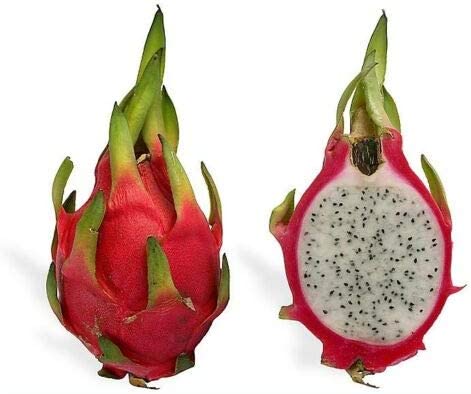Want a foolproof process on how to grow dragon fruit in pots?
Then this post is for you.
Well, you may or may not have heard of this delicacy before…
Dragon fruit–also known as the belle of the night, pitaya, strawberry pear, or cactus fruit–is a product of the Hylocereus spp. (the dragon fruit plant).
It comes in shades of yellow and bright pink with a bright whitish fleshy (sometimes purple-ish) interior, spotting tiny shiny black seeds.
Dense, juicy, and sweet is the perfect definition.
The plant itself—an extensive climbing, tall growing cactus—features chunky succulent-like branches with some of the world’s most giant flowers, popularly referred to as “night-blooming cereus,” considering that they only bloom at night.
The gorgeous white blooms are a spectacular display in the landscape, uplifting and relaxing with their unique tropical scent. But guess what?
They last only for a night.
So you better arm yourself with a flashlight to catch the event once the blooming season sets in, usually from early summer through mid-fall.
Varieties of Dragon Fruit (Plants)

There are mainly three types of dragon fruits:
- Hylocereus undatus: It’s the most common dragon fruit variety; it features pink or red skin with a white interior.
- Hylocereus costaricensis: It’s red-skinned with a purple/red interior.
- Hylocereus megalanthus: It’s yellow-skinned with white flesh.
- Being a subtropical: native to Central America, Mexico, and South America—dragon fruit, though a heat-lover, thrives with good amounts of water.
- It will survive outdoors in mild and humid environments with temperatures between 32 and 900F, essentially in Hardiness Zones ten to twelve (USDA).
- Consider indoor growing—in a pot—if you reside in too-cold or too-warm climates.
How to Grow Dragon Fruit in Pots from Seeds
Before we dive into the process, you’re probably wondering…
How long does dragon fruit take to grow?
It depends on whether you’re growing it from a cutting or seed.
Grown from seeds, dragon fruit cacti may take three to five years to yield fruit. However, you can expect a harvest within nine to twelve months from a cutting.
Dragon Fruit Seeds: Where do you get them?
The easiest way to lay your hands on these precious tinies is by purchasing the fruit from a grocery store.
Slice your ripe dragon fruit in half and scoop out the seeds using a spoon. Rinse off the pulp and flesh from the seeds, then lay them out on parchment paper for a day or until dry.
If you’re not planting immediately, consider storing them in an airtight container for when you need them.
Not available in your local grocery or hardware store? No worries. You can order prepackaged seeds from trusted dealers online.
How to Grow Dragon Fruit From Seeds (Outdoors)
Below is the step-by-step guide to growing dragon fruit from seeds
1 – Select a container for your dragon fruit
Take a small container and make enough holes at the bottom for proper drainage.
2 – Fill the container
Fill the container (three-quarter full) with high-quality potting soil or simply sand, compost, and garden soil in equal parts; then moisten.
3 – Seed the plants
Sprinkle in the seeds, making sure to evenly spread them out. Put in a good amount just in case others fail to germinate.
4 – Cover up the dragon fruit seeds
Cover lightly with additional soil mix and gently press with your hand so the seeds gain proper contact with the soil. You can use a plastic wrap for moisture boost if needed to enhance the germination process. A heat mat is the best option, though. Be sure to keep the medium moist throughout the sprouting period.
5 – Find the perfect spot for the dragon fruit to germinate
Locate the pot in a relatively shady area until germination occurs, then gradually move to a slightly sunny area—not too-hot-of sunlight—so the seedlings don’t fry out.
After a couple of days, expose them to full sunlight.
Dragon fruits require at least six to eight hours of direct sunlight daily for maximum growth and fruiting.
6 – Transplanting
Transplant to a bigger pot (at least ten inches deep and fifteen to twenty-four inches wide) once they strike the 6-inch mark.
7 – Add a trellis to support the weight
The plants begin to add weight at twelve inches high, therefore offering support.
Use a trellis to help keep them in a vertical position so the fruits don’t rest on the ground as they can easily rot. The support system also helps ensure adequate ventilation around the plant, thus reducing the risk of disease.
Note: You can still grow dragon fruit without a trellis; however, it won’t be as productive as when it’s trellised.
Here is how to support the growing plants:
- For not-so-big varieties, use 5-feet tall bamboo sticks.
- Let’s say you have two dragon fruit plants in a pot.
- Take your three sticks; press them down into the soil in the container—to make a triangular shape. Then using a jute rope, interconnect the three so the plants are contained.
- Alternatively, you can opt for the ready-made metallic or wooden trellis or make one yourself.
7 – Keep the soil moist
Water once every week or so to keep the soil moist and not overly wet. (Watering frequency depends on your area’s relative humidity and rainfall).
9 – Pruning
Prune the plant regularly by removing overcrowded, dead, or diseased branches. This helps reduce the chances of fungal disease and insect infestation plus ensures that your cactus grows in line with the support system.
10 – How to Fertilize Your Dragon Fruit
Fertilize moderately with a slow-release low-nitrogen cactus fertilizer or well-decomposed compost once every 45 days.
Since you’re growing outdoors, the nocturnal pollinators will naturally facilitate fruit production, which is not the case with indoor growing.
How to Grow Dragon Fruit Indoors
The process is pretty much the same as with outdoor growing in containers, only that you need to ensure the plant gets the recommended amount of sunlight a day.
- An east-facing window will ensure the plant soaks in a good amount of the morning sun, and to take advantage of the evening portion, shift the container to your West-facing window.
- You can also use supplemental grow lights (full spectrum LED lights) to mimic strong sunlight if, for any reason, you fall short of the natural sunlight.
- Remember, you’re the only available “pollinator” indoors, so the plant depends on you for fruit production, especially for the non-self-pollinators.
- To successfully hand-pollinate your dragon fruit, collect pollen from the stamen of another dragon fruit flower and gently rub it onto your plant’s stigma.
- If you’re pollinating more than one plant, ensure you use a clean cotton swab for each plant.
- Remember that this should be done between dusk and dawn, considering that dragon fruit cactus’ blooms last only a night.
A few indoor varieties include ‘Yellow Dragon Fruit,’ ‘Zamorano,’ ‘Alice,’ ‘Seoul Kitchen’, and ‘Edgar’s Baby.’
How and When to Harvest Your Dragon Fruit
For optimum flavor, delay harvesting until the fruit turns bright pink; cut or twist them off the stalk. Do not wait for the fruits to fall off the stem by themselves; they’ll be overripe.
Store them unpeeled in the refrigerator for up to two weeks or on the countertop for several days until you’re ready to consume.
Final Thoughts on Growing Dragon Fruit From Seeds
You don’t need a green thumb to master how to grow these delicious treats in pots. Simply follow the above tips and enjoy the fruit of your labor, the dragon fruit.


